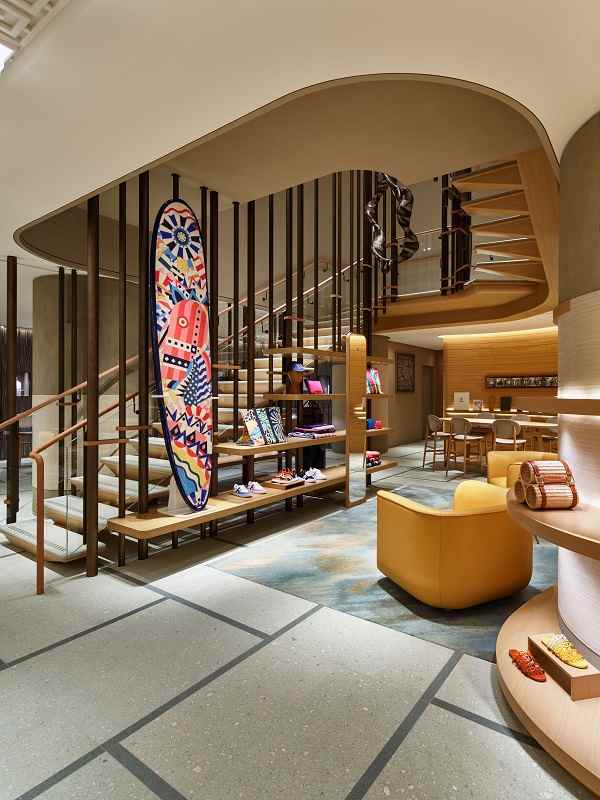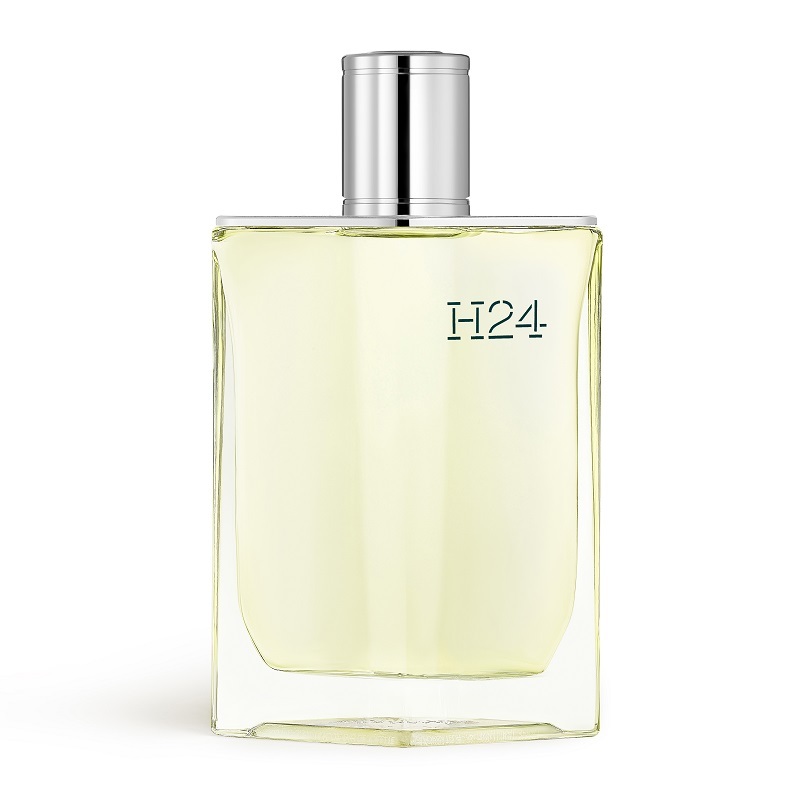
The distinct exterior of Hermes Omotesando Store in Shibuya Ward, Tokyo
10:30 JST, April 2, 2021

A surfboard is seen on display at Hermes Omotesando Store.
Amid the coronavirus pandemic, it is becoming the norm in the fashion industry for unprofitable shops to close down and rare to see a new one pop up. However, on Feb. 28, Hermes opened a new flagship store along Omotesando avenue in Shibuya Ward, Tokyo.
The Hermes Omotesando Store is located in one of the most fashionable districts in Tokyo, right up there with Ginza. What is even more interesting is the store opened while the state of emergency was in effect in Tokyo. All this news created quite a buzz for the store.
The Omotesando store is the 29th shop in Japan for the high-end French fashion brand and the first one to open on a street since Maison Hermes Ginza opened 20 years ago.
Even someone unfamiliar with the fashion industry might wonder, “Why is Hermes opening a new shop along Omotesando now?”
Since around 2000, the basic strategy for luxury brands in Japan is to have two large shops in Tokyo: one in Ginza and one located near Aoyama and Omotesando. Of the five major high-end brands — Louis Vuitton, Chanel, Gucci, Prada and Hermes — all except Hermes followed this strategy.
It took Hermes a long time to open its flagship store in the Aoyama-Omotesando district. I can only assume the reasoning was because there simply wasn’t a building that suited the brand’s image. Basically, the brand required a shop like Maison Hermes Ginza, which is a building that is unique enough to distinguish itself from its neighbors and was artistically designed.
The Hermes flagship shop in Ginza was designed by architect Renzo Piano, whose concept involved using about 15,000 blocks of glass to build the walls. As buildings that could accommodate the design were not easily found, one had to be constructed. However, along Omotesando, there is almost no space left for such a project.
But, like a miracle, one such a building finally came onto the market. The Jingumae Ota building, which is usually called the Ishigaki building, is a strange-looking structure with a stone wall that is two stories tall. I heard that there used to be many buildings that looked similar to it along Omotesando, but now, the Jingumae Ota building is the only one left.
It seems that Hermes had its eyes on the building for a long time. Before Hermes took over the building, it was occupied by the U.S. brand Paul Stuart, operated in Japan by Sanyo Shokai Ltd. Last year, Paul Stuart left the building and moved into the ARGYLE aoyama, which was built on the site of the former Bell Commons shopping mall. I don’t know the reason why Paul Stuart decided to move, but I assume that rent might have been a factor.
Another factor could be because of the building’s design defect. The entrance, which looks as if a hole was bored into the stone wall, gives an oppressive atmosphere with its low ceiling. Hermes left the stone wall as it was and surrounded it with copper-colored stainless steel fences that gave the appearance of a bamboo forest. When it gets dark, the lights installed behind the fence illuminate them beautifully. It is a wonderful way to show respect to the physical building and its history.
Inside, the lights and stairs were strategically placed to solve the issue regarding the low ceiling. The interior is filled with art, including drawings by Francois Houtin and bamboo artwork by Shoryu Honda. The shop looks more like an art museum.
The biggest draw is that the brand’s fragrances and beauty products are available at the shop, including the new men’s fragrance H24, which was launched in time for the shop’s opening, as well as Rouge Hermes, which will be available in mid-April.

H24, the new fragrance for men from Hermes
Special items, such as surfboards and skateboards designed by Jan Bajtlik with Cheval de Fete patterns, are available at the store. These items were produced by Hermes’ special order department.
Japanese designers and artists also played important roles, such as Kohei Kyomori, who designed Hermes scarfs as well as the shop’s window displays, and Daisuke Nomura, who designed some of the company’s cashmere-silk scarfs and ties.
No doubt, we now have another great fashion spot along Omotesando.

Akira Miura
Miura is the editorial adviser of WWD Japan.
"Business" POPULAR ARTICLE
-

Tokyo Economic Security Forum to Hold Inaugural Meeting Amid Tense Global Environment
-

Keidanren Chairman Yoshinobu Tsutsui Visits Kashiwazaki-Kariwa Nuclear Power Plant; Inspects New Emergency Safety System
-

Imports of Rare Earths from China Facing Delays, May Be Caused by Deterioration of Japan-China Relations
-

University of Tokyo Professor Discusses Japanese Economic Security in Interview Ahead of Forum
-

Japan Pulls out of Vietnam Nuclear Project, Complicating Hanoi’s Power Plans
JN ACCESS RANKING
-

Tokyo Economic Security Forum to Hold Inaugural Meeting Amid Tense Global Environment
-

Keidanren Chairman Yoshinobu Tsutsui Visits Kashiwazaki-Kariwa Nuclear Power Plant; Inspects New Emergency Safety System
-

Imports of Rare Earths from China Facing Delays, May Be Caused by Deterioration of Japan-China Relations
-

University of Tokyo Professor Discusses Japanese Economic Security in Interview Ahead of Forum
-

Japan Pulls out of Vietnam Nuclear Project, Complicating Hanoi’s Power Plans

























